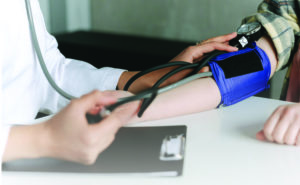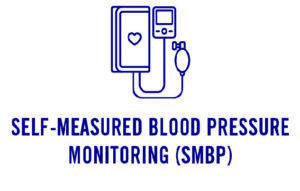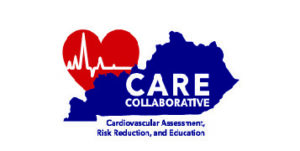 FRANKFORT Hypertension or high blood pressure is a major risk factor for heart disease, stroke, chronic kidney disease, and dementia.1 Heart disease and stroke are the first and fifth leading causes of death in Kentucky, respectively,2 and approximately 38% of adults in Kentucky have hypertension.3 The Kentucky Heart Disease and Stroke Prevention Program at the Kentucky Department for Public Health has created a program that combines self-measured blood pressure monitoring (SMBP) and simple hypertension education via the Cardiovascular Assessment, Risk-Reduction and Education (CARE) Collaborative. The program aims to increase participants’ engagement in their health and work towards improving their blood pressure to address the high burden of hypertension in Kentucky patients.
FRANKFORT Hypertension or high blood pressure is a major risk factor for heart disease, stroke, chronic kidney disease, and dementia.1 Heart disease and stroke are the first and fifth leading causes of death in Kentucky, respectively,2 and approximately 38% of adults in Kentucky have hypertension.3 The Kentucky Heart Disease and Stroke Prevention Program at the Kentucky Department for Public Health has created a program that combines self-measured blood pressure monitoring (SMBP) and simple hypertension education via the Cardiovascular Assessment, Risk-Reduction and Education (CARE) Collaborative. The program aims to increase participants’ engagement in their health and work towards improving their blood pressure to address the high burden of hypertension in Kentucky patients.
What is SMBP?
SMBP is defined as the regular measurement of blood pressure by the patient outside the clinical setting, either at home or elsewhere. It is sometimes known as “home blood pressure monitoring.” Scientific evidence has shown that SMBP plus additional support was more effective than usual care in lowering blood pressure among patients with hypertension. Additional support includes regular one-on-one counseling, web-based or telephonic support tools, and educational classes.4 Through regular out-of-office blood pressure measurements, participants are able to be a part of their treatment and care, providing reliable measurements back to their provider. Participants are trained, through the SMBP program, how to obtain accurate measurements that are reliable for treatment and maintenance decisions. Providers can be reimbursed for initial and continuing SMBP clinical services using CPT codes 99473 and 99474 respectively.
What is the CARE Collaborative?
The CARE Collaborative is a free blood pressure education awareness program for Kentucky men and women over the age of eighteen years. CARE uses three color zones, green, yellow, and red, to indicate if the participant’s blood pressure is normal, elevated, and high, respectively. Individuals document their blood pressure and choose lifestyle modification goals to lower their cardiovascular disease risk.
CARE SMBP

 CARE SMBP combines SMBP with CARE Collaborative education to offer participants tools and resources to improve their blood pressure and overall health. CARE SMBP can be used in any setting where a blood pressure is taken or can be taken. The CARE Collaborative is in use at community clinics, Federally Qualified Health Centers (FQHCs), health care systems, home visiting programs, and local health departments across the state. The program features a free blood pressure monitor, a trained CARE SMBP coach, and patient-centered education and resources.
CARE SMBP combines SMBP with CARE Collaborative education to offer participants tools and resources to improve their blood pressure and overall health. CARE SMBP can be used in any setting where a blood pressure is taken or can be taken. The CARE Collaborative is in use at community clinics, Federally Qualified Health Centers (FQHCs), health care systems, home visiting programs, and local health departments across the state. The program features a free blood pressure monitor, a trained CARE SMBP coach, and patient-centered education and resources.
CARE SMBP coaches are healthcare providers or lay health professionals trained by the Heart Disease and Stroke Prevention Program to engage participants about their blood pressure. During the first CARE SMBP participant encounter, the participant is given a blood pressure monitor and instructed on how to properly use the device. The participant then uses the teach back method to demonstrate understanding of proper use and cuff positioning to accurately capture their blood pressure. Next, the participant receives education on the CARE Collaborative. After the participant’s blood pressure is measured, they are asked to identify which blood pressure zone they fall in: normal (green), elevated (yellow), or high (red). This identification and ownership of their blood pressure zone is crucial for participants to become engaged in their health and begin healthy behaviors and/or lifestyle modifications to reduce their blood pressure. The CARE SMBP coach then works with the participant to find one simple step they can take to reduce their blood pressure. Some examples of modifiable behaviors that a participant can focus on include taking their medication as directed, healthy eating, reducing tobacco use, increasing physical activity, reducing blood sugar, reducing cholesterol, and weight loss. At subsequent CARE SMBP encounters, the coach discusses any blood pressure changes since the previous visit and works with the participant to determine if additional healthy behaviors or lifestyle modifications can be made. One of the main goals of the program is for participants to share their self-measured blood pressure readings with their healthcare providers, resulting in better informed clinical decision-making relative to hypertension.
CARE SMBP pilot sites have shown reductions in participants’ systolic and diastolic blood pressure. Patients enrolled in CARE SMBP at a clinical partner site demonstrated a mean reduction of 12 mm Hg in systolic blood pressure and 6 mm Hg in diastolic blood pressure. A meta-analysis on hypertension revealed that every 10 mm Hg reduction in systolic blood pressure lowers the risk of major cardiovascular disease events by 20%, coronary heart disease by 17%, stroke by 27%, heart failure by 28%, and death from all causes by 13%.5 Patient engagement and education is a crucial part of the CARE SMBP program. We measure success in this area by a participants’ ability to correctly identify their blood pressure zone according to colors. At the same CARE SMBP site, 90% of participants were able to identify their blood pressure zone correctly and 80% made improvements in their blood pressure. These findings show that CARE SMBP program is helping participants make the connection between their blood pressure number and the risk category they fall in.
These positive outcomes show the CARE SMBP is making a difference for participants with high blood pressure in Kentucky. Although there is still much work to be done to reduce the burden of hypertension, we feel confident that the CARE SMBP program provides a way to minimize hypertension burden and improve heart health of Kentuckians.
Anyone interested in learning more about the CARE SMBP program is invited to contact the Kentucky Heart Disease and Stroke Prevention Program at Khdsp@ky.gov or at 502.564.7996.
Samantha Albuquerque, DrPH, is the epidemiologist with the KY Heart Disease and Stroke Prevention Program at the KY Department for Public Health. She has a DrPH in epidemiology and environmental health from the University of Kentucky, a MS in chemistry from Georgetown University, as well as a MS and BS in chemistry from the University of Mumbai. Prior to working in heart disease and stroke she carried out research in malaria, enteric viruses, occupational health, asthma, and COPD.
Natalie Littlefield is the CARE SMBP program director with the KY Heart Disease and Stroke Prevention Program at the KY Department for Public Health. She has an MPH in health behavior from the University of Kentucky and a BS in exercise science from Murray State University. Prior to working for the Department for Public Health she worked in community outreach and development with UnitedHealthcare and the American Heart Association.
1Fuchs, F.D. & Whelton, P.K. (2020). High Blood Pressure and Cardiovascular Disease Hypertension 75 (2), 285-292. https://doi.org/10.1161/HYPERTENSIONAHA.119.14240 Accessed at https://www.ahajournals.org/doi/epub/10.1161/ HYPERTENSIONAHA.119.14240 on Nov 29, 2021.
2Centers for Disease Control and Prevention, National Center for Health Statistics. Underlying Cause of Death 1999–2019 on CDC WONDER Online Database released in 2020. 2019. Accessed at https://wonder.cdc.gov/controller/datarequest/D76;jsessionid=E76D448C9E254A592E53234C2E56.
3Centers for Disease Control and Prevention, National Center for Chronic Disease Prevention and Health Promotion, Division of Population Health. BRFSS Prevalence & Trends Data. 2019. Accessed at https://www.cdc.gov/brfss/brfssprevalence/.
4Centers for Disease Control and Prevention. Self-Measured Blood Pressure Monitoring: Action Steps for Public Health Practitioners. Atlanta, GA: Centers for Disease Control and Prevention, US Dept of Health and Human Services; 2013. Accessed at https://millionhearts.hhs.gov/files/MH_SMBP.pdf.
5Ettehad, D., Emdin, C.A., Kiran, A., Anderson, S.G., Callendar, T., Emberson, J. et. al. (2016). Blood pressure lowering for prevention of cardiovascular disease and death: a systematic review and meta-analysis. Lancet, 387 (10022), 957-967. Accessed at https://doi.org/10.1016/S0140-6736(15)01225-8.


